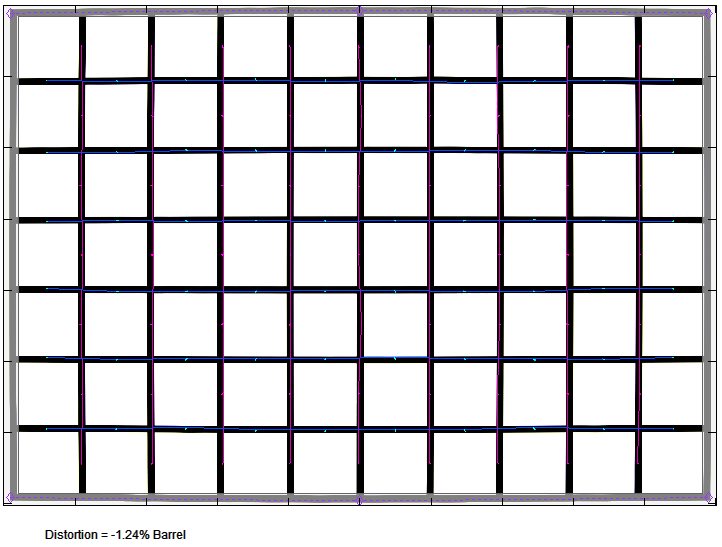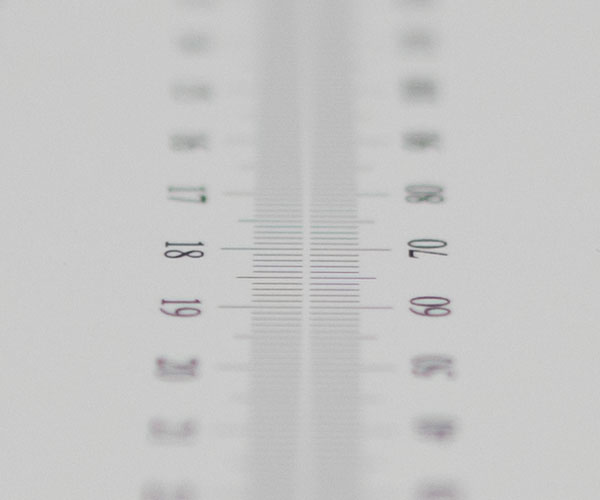|
Sigma 24mm f/1.4 DG HSM | A - APS-C Format Review / Test - Analysis |
|
Lens Reviews -
Canon EOS (APS-C)
|
|
Page 2 of 2

Distortion
The lens produces a slight to medium amount of barrel distortion (1.2%). Interestingly this is a bit worse compared to the findings in our full format test although this remains unobtrusive.

Vignetting
Full format lenses enjoy a sweet spot advantage when used on APS-C cameras. This is also obvious on the Sigma 24mm f/1.4 HSM DG | A. It showed a rather massive vignetting in the full format scope but it's not a big deal here. At f/1.4 you may spot some light falloff in critical scenes but the issues is gone at f/2 already.

MTF (resolution)
The resolution characteristic of the Sigma lens is somewhat disappointing. The center quality is very good even at f/1.4 and great in the mainstream settings beyond. However, the outer image region leaves something to be desired especially at large apertures. At f/1.4 the borders are slightly soft, more so the extreme corners. The quality improves slowly the more you stop down but the ceiling is reached just beyond the good mark. Full format lenses tend to be better than that on APS-C cameras.
The centering quality of the tested sample was good.
Please note that the MTF results are not directly comparable across the different systems!
Below is a simplified summary of the formal findings. The chart shows line widths per picture height (LW/PH) which can be taken as a measure for sharpness.
If you want to know more about the MTF50 figures you may check out the corresponding Imatest Explanations

Chromatic Aberrations (CAs)
Chromatic aberrations (color shadows at harsh contrast transitions) are well controlled with an average pixel width between 0.6px (f/1.4) and 0.9px (f/8) at the image borders.

Bokeh
One of the primary usage scenarios for a large aperture lens is to separate the main subject from the background. In such an image the quality of the bokeh (out-of-focus blur) is of major significance.
Wide-angle lenses, especially those with many aspherical elements, are not the best performers in this category but the Sigma is way above average here (in this class). In our test scene below the Sigma shows a bit of nervousness in the focus transition zones but we've seen much worse here really. However, it should be mentioned that there is some smearing at the image borders/corners.
 A surprising finding is that out-of-focus highlights are rendered quite beautifully with a comparatively smooth inner zone and only slight outlining of the highlight discs. Thanks to the APS-C format the highlight disc shape is barely deteriorating towards the corners.
A surprising finding is that out-of-focus highlights are rendered quite beautifully with a comparatively smooth inner zone and only slight outlining of the highlight discs. Thanks to the APS-C format the highlight disc shape is barely deteriorating towards the corners.

Bokeh Fringing / Longitudinal Chromatic Aberrations (LoCA)
LoCAs (non-coinciding focal planes of the various colors) are a common issue with relatively fast glass. As you can notice below the halos have different colors - magenta (red + blue) in front of the focus point and green beyond. Truly "apochromatic" lenses don't show LoCAs but these lenses are very rare especially below 100mm. Unlike lateral CAs, LoCAs cannot be fixed easily in post processing.
Typical for most ultra fast primes the Sigma shows a certain amount of bokeh fringing at large aperture settings but the result is above average here again. The fringing can be reduced by stopping down and it's mostly gone from f/2.8 onward.
In addition, these shots also illustrate that there is virtually no focus shift when stopping down.
|
Move the mouse cursor over the f-stop marks below to observe the respective LoCAs
|
| f/1.4 |
f/2 |
f/2.8 |
f/4 |
|

|
Verdict
Sigma has delivered some magic during recent years but the Sigma 24mm f/1.4 DG HSM | A stayed short of our expectations. The lens wasn't overly impressive on our full format camera and, surprisingly, it isn't all that hot in the APS-C scope either. There is nothing wrong with the image center which is very sharp even at fully open aperture. However, the outer image region is less convincing. The extreme corners are even soft at f/1.4. The peak performance around f/5.6 is far from being bad but the Sigma is a fairly expensive prime lens so a good to very good outer region isn't good enough honestly speaking. The lateral CAs are low and not disturbing. The same goes for the slight barrel distortion. Thanks to the crop format, vignetting is a lesser issue. The quality of the bokeh is decent especially regarding the rendition of out-of-focus highlights - at least in the inner image zone. You may spot a bit of bokeh fringing at large apertures but it's not obtrusive.
The build quality is clearly up to professional standards ... except for the lack of weather sealing. AF speed isn't a primary aspect on a 24mm lens but Sigma's HSM does a pretty fast and silent job here.
The Sigma lens remains interesting primarily because of its speed, less so regarding its performance characteristic.
|